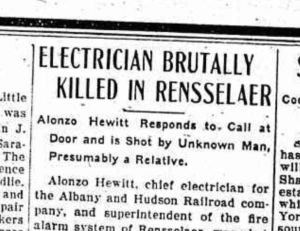 Most things on Hoxsie are found when we’re looking for other things. This is one of those things: while searching for some background on the Albany and Hudson Railroad, we came across a brief mention in the San Francisco Call of May 17, 1907 of the murder of the railroad’s chief electrician, Alonzo Hewitt. Turns out the local papers covered that little event, too.
Most things on Hoxsie are found when we’re looking for other things. This is one of those things: while searching for some background on the Albany and Hudson Railroad, we came across a brief mention in the San Francisco Call of May 17, 1907 of the murder of the railroad’s chief electrician, Alonzo Hewitt. Turns out the local papers covered that little event, too.
Hewitt was a resident of the city of Rensselaer, who had previously worked as a lineman for the power side of the business that eventually became the A&H Railroad. He was also the foreman of the Mink & Claxton Hose Company and superintendent of the fire alarm system of Rensselaer. He invented a new style of shoe for a train’s contact with the third rail that prevented the formation of ice, in 1901.
At about 7:30 on a Thursday night in May, the 16th to be exact, in 1907, Alonzo Hewitt went to his home at the corner of Glen and Fourth streets and, according to the Amsterdam Evening Recorder,
going into the sitting room, removed his coat and shoes and laid down on a lounge. In a few minutes the door bell rang, and his 12-year-old daughter, May, answered the ring. She saw a man standing on the piazza, whom she later described as in general resembling her mother’s cousin, Peter Lozon. The man asked for her father and she turned to call him.
On his daughter’s call, Hewitt sprang up and went to the door, May standing back of it. As he appeared in the doorway, the unknown assassin fired a shot gun at him point blank, shooting him in the throat. The murderer then fled.
Hewitt died half an hour later, and the police scoured the city for Lozon. The Recorder reported that
the supposed motive is found in a family quarrel. Hewitt was to have appeared this morning in court to answer to a charge of assault preferred by Roscoe Lansing. It is alleged that Hewitt had assaulted Lansing on the street because Lansing had been circulating stories in the saloons that Hewitt had beaten his wife. Lozon, the suspected murderer, is a brother-in-law of Lansing, and is also a cousin of Hewitt’s wife.
The Troy Daily Times, reporting on the 20th that there was a warrant for the arrest of Lozon, said the district attorney and police were satisfied that the crime was the outcome of a family feud and that the murder had been premeditated for some time, possibly with the involvement of others. Mrs. Hewitt, who was left with six children to tend to (May was the eldest), made a statement corroborated by neighbors that Mr. Hewitt had been under threat of his life for some time.
Wednesday night [the night before the murder] Mr. and Mrs. Hewitt were awakened from sleep by incessant ringing of the doorbell, and only through the persuasions of his wife was Mr. Hewitt prevented from responding to the call. They had just dozed again, says Mrs. Hewitt, when they were startled by the report of a revolver, and a bullet whizzed past the bedroom window. Someone was heard prowling about the yard and barn for some time after, but Mr. Hewitt did not get within range of the windows. Neighbors, who corroborated the statement, said that for some time the Hewitts were persecuted by some unknown persons and were frequently aroused in the night by the ringing of the doorbell.
On the afternoon before the murder, Hewitt told a saloon keeper on Partition Street that he had just had an argument with Lozon. “It is said that Lozon and Hewitt were the best of friends until Hewitt, an electrician for the Albany and Hudson Railway, discharged Lozon.”
Lozon’s plan always had to have been to skip town, because he hardly kept his plans quiet. For starters, he borrowed the murder weapon, which he dropped in the street nearby, from someone who lived nearby at Catherine and Fourth. In Joseph Ayers’s saloon at First and Harrison, Lozon ordered a drink and made a show of paying for it with a $2 bill, which apparently was about $2 more than he normally had on hand – he had previously in the day tried to get a haircut on credit.
Lozon said to Mr. Ayers, “You’ll be a witness,” but when asked what he meant he failed to explain. He called in two or three other men from a rear room to drink with him and repeated his declaration that they would be “witnesses.” They laughed and one asked, “What are you going to do, the Dutch act?” (meaning suicide.) “No,” replied Lozon, “there’s something doing,” and he put his hand on his coat pocket significantly. A little later Lozon was seen going over Catherine Street, and he went to the home of William F. Arris at Catherine and Fourth Streets and borrowed his gun, saying he was going coon hunting. Mr. Arris remarked that it was a poor night for hunting, but Lozon was insistent and asked for some shells.
Hewitt was buried in Albany Rural Cemetery. Lozon, as far as we can tell, was never found; police believed he had headed directly for the rail yards and grabbed a freight out of town. The 1908 Rensselaer Directory, in listing the rest of his family at 59 Pine Street, notes that Peter Lozon “moved from city.”

Leave a Reply